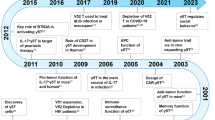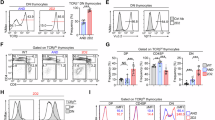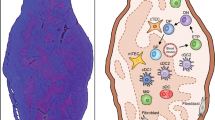Abstract
DURING their intrathymic differentiation, T lymphocytes expressing αβ T-cell receptors (TCR) are negatively1–3 and positively selected4–8. This selection contributes to the establishment of self-tolerance and ensures that mature CD4+ and CD8+ cell populations are restricted by the self major histocompatibility complex. Little is known, however, about γδ T-cell development. To investigate whether selection operates in the establishment of the γδ T-cell class, we have generated transgenic mice using γ- and δ-transgenes encoding a TCR that is specific for a product of a gene in the TL-region of the TLb haplotype. Similar numbers of thymocytes expressing the transgenic TCR were generated in mice of TLb and TLd haplotypes. But γδ thymocytes from TLb and TLd transgenic mice differed in cell size, TCR density and in their capacity to respond to TLb stimulator cells or interleukin-2 (IL-2). In contrast to γδ T cells from TLd transgenic mice, γδ T cells from TLb transgenic mice did not produce IL-2 and did not proliferate in response to TLb stimulator cells, but they did proliferate in the presence of exogenous IL-2. These results indicate that functional inactivation of self-antigen-specific T cells could contribute to the establishment of self-tolerance to thymic determinants.
This is a preview of subscription content, access via your institution
Access options
Subscribe to this journal
Receive 51 print issues and online access
$199.00 per year
only $3.90 per issue
Buy this article
- Purchase on SpringerLink
- Instant access to full article PDF
Prices may be subject to local taxes which are calculated during checkout
Similar content being viewed by others
References
Lederberg, J. Science 129, 1649–1653 (1959).
Kappler, J., Roehm, N. & Marrack, P. Cell 49, 273–280 (1987).
Kisielow, P., Bluthman, H., Staerz, U., Steinmetz, M. & von Boehmer, H. Nature 333, 742–748 (1988).
Sprent, J., Lo, D., Gao, E. H. & Ron, Y. Immunol. Rev. 101, 173–190 (1988).
Teh, H. S. et al. Nature 335, 229–233 (1988).
Sha, W. C. et al. Nature 335, 271–274 (1988).
Blackman, M., Marrack, P. & Kappler, J. Science 244, 214–217 (1989).
Berg, L. J. et al. Cell 58, 1035–1046 (1989).
Takagaki, Y., Nakanishi, N., Ishida, I., Kanagawa, O. & Tonegawa, S. J. Immun. 142, 2112–2121 (1989).
Bonneville, M. et al. Proc. natn. Acad. Sci. U.S.A 86, 5928–5932 (1989).
Ishida, I. et al. Proc. natn. Acad. Sci. U.S.A. (in the press).
Tonegawa, S. et al. Cold Spring Harb. Symp. quant Biol. (in the press).
Itohara, S., Nakanishi, N., Kanagawa, O., Kubo, R. & Tonegawa, S. Proc. natn. Acad. Sci. U.S.A 86, 5094–5098 (1989).
Toribio, M. L. Gutierrez-Ramos, J. G., Pezzi, L., Marcos, M. A. R. & Martinez-A, C. Nature 342, 82–85 (1989).
Schwartz, R. H. Cell. 57, 1073–1081 (1989).
Rammensee, H-G., Kroschewski, R. & Frangoulis, B. Nature 339, 541–544 (1989).
Win, D. et al. J. exp. Med. 169, 779–794 (1989).
Lo, D. et al. J. exp. Med. 170, 87–104 (1989).
Ramsdell, F., Lantz, T. & Fowlkes, B. J. Science 246, 1038–1041 (1989).
Author information
Authors and Affiliations
Rights and permissions
About this article
Cite this article
Bonneville, M., Ishida, I., Itohara, S. et al. Self-tolerance to transgenic γδ T cells by intrathymic inactivation. Nature 344, 163–165 (1990). https://doi.org/10.1038/344163a0
Received:
Accepted:
Issue date:
DOI: https://doi.org/10.1038/344163a0
This article is cited by
-
Antigen-restricted γδ T-cell receptors?
Archivum Immunologiae et Therapiae Experimentalis (2009)
-
Tissue distribution, antigen specificity and effector functions of γδ T cells in human diseases
Springer Seminars in Immunopathology (2000)
-
The enigmatic specificity of γδ T cells
Immunologic Research (1995)
-
Limiting dilution analysis in leprosy
Immunology & Cell Biology (1992)
-
Apoptosis in the development of the immune system: Growth factors, clonal selection and bcl-2
Cancer and Metastasis Review (1992)



